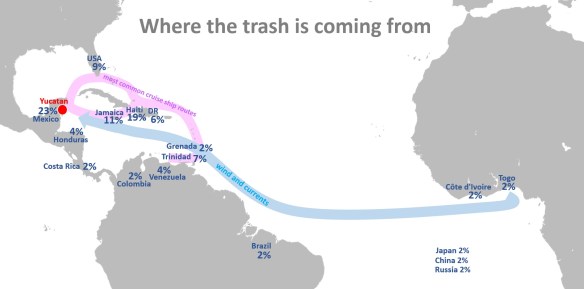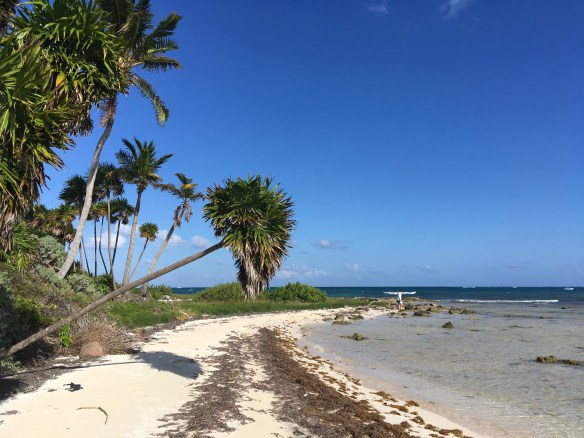
Plastics and rotting sargassum, Sian Ka’an Biosphere Reserve, Quintana Roo, Mexico
The beaches south of Cancun, Mexico were once famed for their talcum powder white sand and leaning coconut palms. Now they tell you a lot about the world.
Waves pile sargassum seaweed up to ten feet high along the waters edge while the sun cooks the rotting vegetation higher on the beach. I saw it about two feet high. It smells and traps baby sea turtles, preventing them from reaching the sea. And it’s not from Mexico. Sargassum is a floating algae, different from the seagrass that is anchored to the sea bottom offshore. Fed by warming seas and nutrients from agricultural runoff from the Amazon and other rivers to the south, sargassum has bloomed in recent years. Wind and currents bring it to the Yucatán Peninsula, where it has affected tourists’ enjoyment of the beaches.
CLICK PHOTO TO ENLARGE
But that’s not all. The beaches are littered with plastic garbage— mostly bottles and containers associated with beverages, personal care products, or automotive fluids. I couldn’t read the labels on most of them— they had clearly been at sea too long, drifting from too far away– but it appears most of them are not from Mexico either. Of the 47 labels I could read, here are the results.
CLICK TO ENLARGE

I searched about 400 meters of beach at the Sian Ka’an Biosphere Reserve, south of Tulum, Mexico on the Yucatán Peninsula. There were about a thousand plastic containers. I could only read the labels on 47 of them. They came from all over the Caribbean, as well as Central and South America, and even West Africa and Asia.
The countries of origin based on the labels on the plastic containers are correlated with distance and currents. Cruise ships are an unlikely source– dumping plastics at sea has been banned for over a decade in the Caribbean.
The disproportionate percentage of plastics from Haiti (mostly energy drinks) suggest this trash comes primarily from land-based sources, not cruise ships, and is correlated with poverty and the ability to address garbage. The high percentage from the US may be from local tourists or even Puerto Rico. Mexico is undoubtedly over-represented in my sample– those plastics come from the nearest and are likely less degraded and easier to read. Given that over 95% of the containers were so worn they were unreadable, it is likely they drifted from far away.

This beach, the lee of a point, was the cleanest one I encountered.


